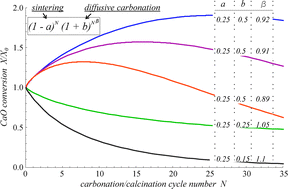CO2 multicyclic capture of pretreated/doped CaO in the Ca-looping process. Theory and experiments
Abstract
We study in this paper the conversion of CaO-based CO2 sorbents when subjected to repeated carbonation–

* Corresponding authors
a
Faculty of Physics, University of Seville, Avenida Reina Mercedes s/n, 41012 Sevilla, Spain
E-mail:
jmillan@us.es
b Instituto de Ciencia de Materiales de Sevilla (CSIC-University of Seville) Americo Vespucio 49, 41092 Sevilla, Spain
We study in this paper the conversion of CaO-based CO2 sorbents when subjected to repeated carbonation–

 Please wait while we load your content...
Something went wrong. Try again?
Please wait while we load your content...
Something went wrong. Try again?
J. M. Valverde, P. E. Sanchez-Jimenez, A. Perejon and L. A. Perez-Maqueda, Phys. Chem. Chem. Phys., 2013, 15, 11775 DOI: 10.1039/C3CP50480H
To request permission to reproduce material from this article, please go to the Copyright Clearance Center request page.
If you are an author contributing to an RSC publication, you do not need to request permission provided correct acknowledgement is given.
If you are the author of this article, you do not need to request permission to reproduce figures and diagrams provided correct acknowledgement is given. If you want to reproduce the whole article in a third-party publication (excluding your thesis/dissertation for which permission is not required) please go to the Copyright Clearance Center request page.
Read more about how to correctly acknowledge RSC content.
 Fetching data from CrossRef.
Fetching data from CrossRef.
This may take some time to load.
Loading related content
